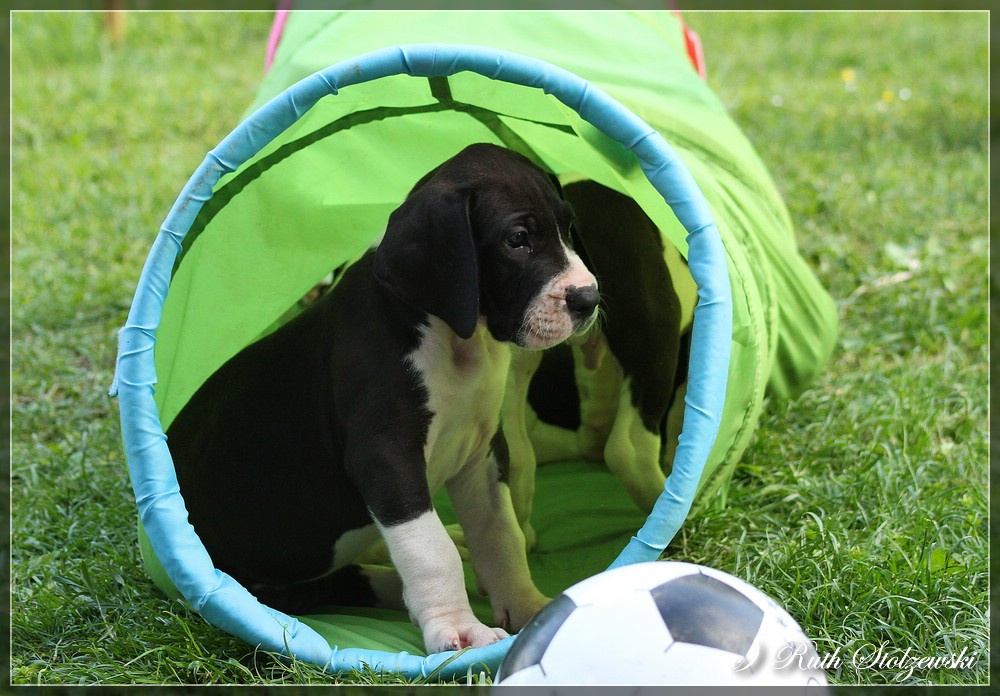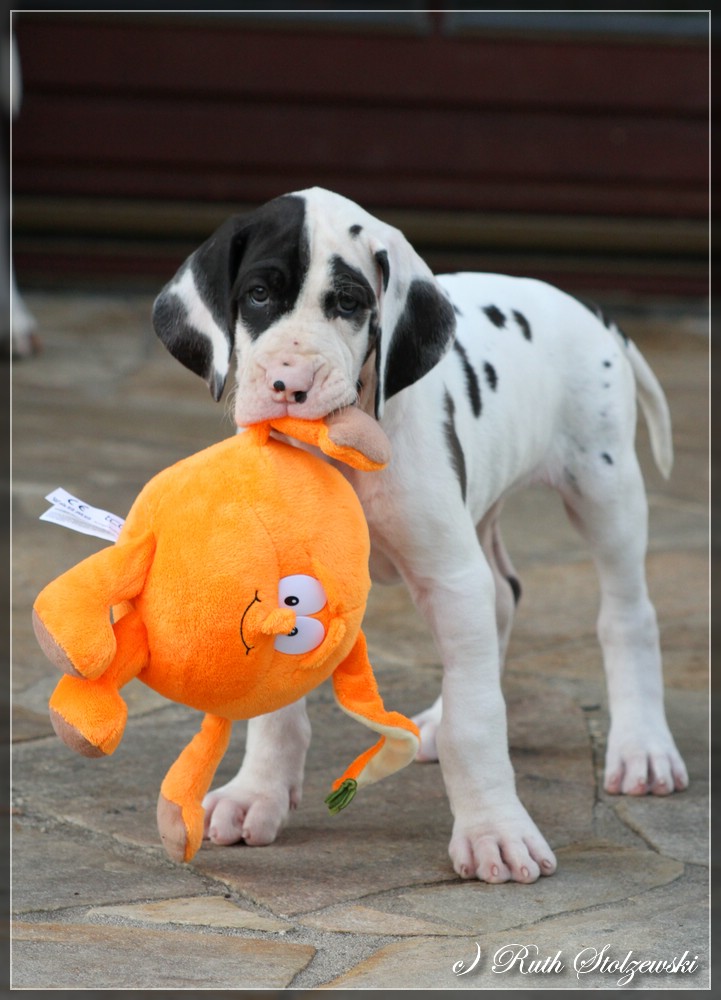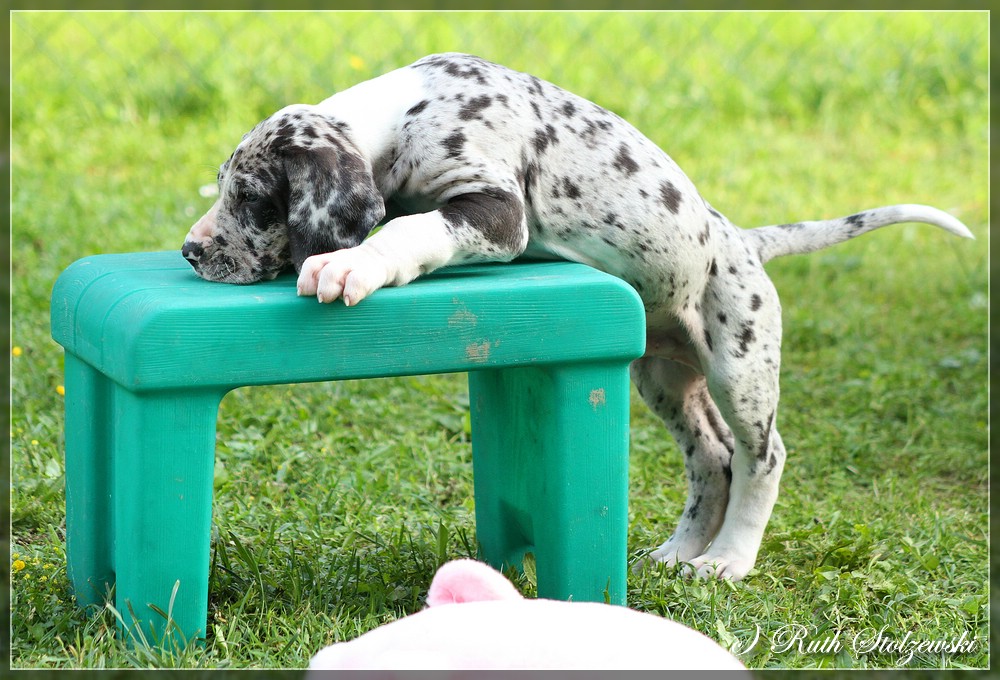Great Danes are impressive, noble and beautiful. And puppies are so cute. The temptation is big to get one, but does this breed really fit to you and your family? And can you offer the right conditions to have a dog in general?

A Great Dane has first of all the same needs than any other dog. The most important factor is time!
- Factor Time: a puppy cannot be left alone at all in the first weeks after it has moved into its new home. This has to be trained very slowly and the earliest at the age of about one year a dog can be left alone for several hours a day (without destroying the house and this way also endangering itself). When you and your family members – if existing – are outside the home all day long then a dog is definitely not the right pet. Dogs are social animals and leaving them alone for more than 6 hours a day all week long is animal torture. What dogs need the most is being close to their owners and being loved!
- Factor Space: as a Great Dane owner you often get asked if you live in a big house, or if the dog has its own room, or if it lives in the house at all but in a kennel because it is soooooo huge. Well, for a Great Dane (and any other dog) it doesn’t matter at all if it lives in a castle with 20 rooms or in a one-room appartment, as long as its basic needs are fulfilled. Those are besides food, water, a comfortable bed and exercise first and foremost social contact, as mentioned above. Great Danes are lapdogs in the body of a calf, and they are anyway always as close as possible to their owners. So for a Great Dane a small home can even be better, because it doesn’t have to search its loved ones on 300 sqm 😉 The question is not: how big is your house? but: how big is your sofa? And your heart? Even a garden is not necessary if you want to keep a Great Dane. Due to their short hair and their affectionate character they are absolutely not suitable to live outside! Of course, a garden is comfortable to have for the owner, because he or she doesn’t have to go for a walk for every loo, but can just open the terrace door. However this may also seduce to becoming lazy. It is important for every dog, nevermind which breed or age, to go for a walk outside the own premises at least once a day! Otherwise it will become emotionally and physically stunted. Especially younger Great Danes need a lot of action outside. Inside the house Danes are usually quiet and in my opinion much more suitable to live in a city than small, active breeds like Terriers for example. I lived with my first Great Dane Ludwig in the center of Berlin for 7 years in an appartment and it was no problem at all. The opposite: he had lots of exercise and new impressions every day.
- Factor Money: the financial question is not completely unimportant when you want to get a Great Dane, and the price of the puppy is the lowest expense factor. If the cost of a purebred puppy with FCI pedigree seems too high for you (it will be sth. between 1500 and 2500 Euros/or 15.000 until 25.000 Swedish Krones/depending on the breeder, color, etc) then you definitely cannot afford to own this giant breed. The yearly maintenance cost of a Great Dane is about the same as the puppy price. So you have to calculate on at least 120 until 200 Euros (1200 until 2000 SEK) for food, insurance and supplies per month. For a healthy dog that doesn’t need daycare! Even with an insurance you will have to pay part of the veterinary costs by yourself and they are abnormally high. Dogsitters, schools and other services also have its price. You don’t have to be a millionaire to own a great dane, but you should have some financial reserves.

When you consider that you can offer enough time, space and money for a big dog, you will probably ask yourself if a Great Dane suits your/your family’s mentality and preferences. So how is the character of this breed? Well, first of all every Great Dane is an individual with its own personality. But there are certain traits which characterize this breed. They are summarized in the breed standard (FCI No. 235):
Friendly, loving and devoted to his owners. Might be reserved towards strangers, but required is a confident, fearless, easily tractable, docile companion and family dog with high resistance to provocation and without aggression.
Great Danes are often described as “gentle giants”, and this leads to the misunderstanding, that they are born as friendly couch potatoes who don’t have to be trained. Well, this is wrong! The first requirement for a Dane to become a “gentle giant” is a good breeder who selects on a sound temperament and socializes its puppies well in the first weeks. And then it’s the owner’s turn to continue this dedicated work: a Great Dane has to be brought up consequently from the very first day it moves in into its new home. The puppy has to get to know the world and to learn the rules of life.



Great Danes grow incredibly fast in the first year of their life, but they are grown up only at the age of 2-3 years. This means that this giant has reached about 90% of its final size and weight already at the age of one year, but it is not yet physically mature and in the head it is like a teenager in puberty. So you have to be prepared to deal with a capricious 60-80kg youngster and this is even more demanding if you didn’t train properly with the puppy in the months before. A young Great Dane has furthermore a much bigger need to be mentally and physically stimulated than an older one. And they have to learn to calm down at home, to tolerate frustration and to control their impulses. And you are the one who has to teach this to the dog!

So don’t expect a one year old Great Dane to be an unchallenging couch potato that is satisfied by going into the garden three times a day for a loo. If you are searching for a dog that lies decoratively on the sofa the whole day a Great Dane is the wrong breed! They were originally bred for chasing and gripping large game, they are active and agile and some even still have a good portion of hunting instinct. So they need exercise and they are ready to go with you everywhere. Great Danes are not difficult to train, they learn quickly. But they can be a bit stubborn and it takes a while until the command has travelled from the brain into the body parts, because the distance is so long 😉 So don’t expect a Dane to react like a Malinois! And fortunately they are not as demanding as a Sheperd or a Husky who needs a task to be happy or who needs to run 40 km every day. This is what I like so much about Great Danes: they are quite flexible. You can train nosework, agility or obedience with them but you don’t have to. But they definitely need to be activated every day!



As described in the standard above, a Great Dane is affectionate and loyal towards its family and friends. They love to cuddle and need to be close to their owners to thrive and it is animal cruelty to keep them in a kennel. Danes can be very gentle and fine-motor. But they can also be very clumsy and the paw or tail swipe of a 60 kg dog can be painful and even cause black bruises. I always admire children who grow up with Great Danes for their steadfastness 😉 But besides the occasional gross motor activity Great Danes are usually very good family dogs and are also gentle with other animals in the house. I also breed cats, and none of my dogs has ever – not even unintentionally – hurt one of my kittens.

Towards strangers a Great Dane is “allowed” to be reserved according to the standard. And this means in simple words: most Danes have a more or less distinct guarding instinct. They protect their family and territory, but usually only with barking. They shall not be aggressive or even bite! So the guarding instinct has to be regulated and directed into the right channels from puppy age. The young Great Dane – and actually every dog – has to learn that it is not about him to control the family and territory but that this is the task of the owners. A well socialized and trained Great Dane will tolerate to be touched by any stranger. But if you want a dog that rarely barks and greets every stranger with a wiping tail it is maybe better to get a Border Collie or a Labrador.
Now you are maybe sure that you really want to have a Great Dane and the last question to answer is: a male or a female?
Considering devotion and cuddlyness the both genders don’t differ much. Often males are even a bit more sensitive and real mommy’s boys. They are usually taller and heavier as females and have a bigger head with more lip, which increases the risk for slobering. In my experience the biggest difference between the genders is the puberty. This demanding phase usually starts at around 9 months and ends around 24 months of age. Males tend to test out themselves more then and try to impress same-gender dogs and flirt with females. It can be tough to have a 80 kg bully on the leash who pulls and barks at other dogs. So going on the leash and social contact with other dogs have to be trained well in this time – and if you have already trained eagerly with the puppy you will maybe not face these difficulties at all. Females also come into the puberty and may “forget” their commands and strain their owners. But usually they don’t tend to show off that much towards other dogs. Anyway there exists also the occasional “bitch” which doesn’t get along with other dogs. Females come in heat usually the first time around 9-12 months and then about every 6 months and this includes hormonal and temperament changes. This means their mood is not constant over the course of their cycle. Women may understand what I am talking about. Their partners maybe too 😉 Males are more constant and “stable”, but are on the other hand always “ready”.

Some people think, ok, no problem, I will just neuter the puppy and don’t have any problems at all with gender-typical misbehaviour. And maybe I don’t even have to train the dog. Well, this is not only wrong, this is even abusive. Would you neuter your children or your partner because they show traits which are characteristic for their gender and maybe don’t “obey” the way you want? No of course not, because you love them and accept them for who and what they are. The gender is an integral part of a human’s and animal’s personality and sexual hormones are not only there to steer sexuality, but they also have many other functions in the body. They influence the whole metabolism and the development of the organism. I am not against neutering dogs in general. There can be occasions when it makes sense, for example when you have a pack with mixed sexes. Or when you have a female that suffers immensely from her false pregnancies. And there are medical reasons of course, such as prostata problems, cryptorchism or pyometra. But a dog should never be neutered (except for emergency cases of course) before it is adult. For giant breeds this means before the age of 24 months minimum. Sexual hormones regulate the growth of the dog and when it is neutered too early its bones grow longer whilst the muscles and joints stay underdeveloped. This results into a completely unbalanced anatomy and orthopedic problems. The effects of early neutering are even worse in giant, fast growing breeds such as Great Danes. Their bone growth is only completed at the age of 18 months, but the development of their muscles, joints and tendons will only finish with 24-36 months. Not talking about their mind which needs even more time to mature. So please, give your dog the chance to grow up completely, not only physically but also mentally, before you neuter it. And don’t expect that neutering will solve training problems. This is your task! If you don’t want a “masculine” or “feminine” dog, don’t get a dog at all! Or are you going to cut the vocal chords of a dog because it barks?
When you can relate to what you read on this page and are interested in one of my puppies, you can fill out the application form (without any engagement!). You can answer in English, German or Swedish!
